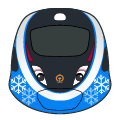
Have a extraordinary journey
After decades of development, China's high-speed railway network has spread throughout the country, and high-speed trains have become the preferred choice for passenger travel.
Chinese standard EMU and DMU train
The project of Chinese standard EMU train started development in 2013 and the first train made its debut in 2015, the passenger operation started in 2017. It has five major categories incluing CR450, CR400, CR300, CR220, and CR200 through years of development. It covers passenger trains of different power including electric, diesel and hybrid, with speeds ranging from 160 to 400 KPH, It has also given rise to freight trains and high-speed comprehensive inspection trains and so on. It already at the forefront of the world in multiple aspects. As of 2024, there are over 1500 Fuxing trains operating on all major high-speed railway lines.

The Hexie train was originally designed by internationally renowned giants based on the characteristics of Chinese railways. Different models of trains have different national flavors. Due to the lack of unified technical standards at the beginning, the operation methods, maintenance and repair processes of different trains are different, resulting in relatively high usage costs. After continuous improvement, numerous models that better meet practical needs have been derived. Production began in 2006 and end at 2017, nearly 2500 trains had been produced.

The Cinova and CJ train are mainly used for short distance intercity and intra city railways, the maximum speed is between 140 and 200 KPH. It has the characteristics of large standing space and high passenger capacity, and its acceleration and braking performance are also more suitable for lines with short station spacing. Most Cinovas operate on locally operated railways, rather than CR, therefore, the painting styles of Cinovas are very diverse.
本站已运行4161天。
列车开往的方向并不重要,
重要的是窗外的风景和看风景的心情。
处在嘈杂的动态中,
却是静而细腻的心思。